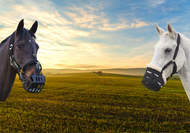There is a school of thought that considers grazing muzzles as cruel and unnatural punishment for horses, restricting their ability to graze on spring and summer grass. How much more cruel is it, however to allow a horse prone to obesity to guzzle grass at will, resulting in all sorts of metabolic health problems?
It’s important to remember that grazing muzzles are used to cut down the ingestion of grass, not to prevent him from eating at all.
Weight Management
Horses that tend to gain weight or are susceptible to laminitis need a grazing muzzle as part of a weight management plan.
According to the British Horse Society (BHS) it’s wise to consider using a grazing muzzle with other weight control measures before your horse reaches a body condition score (fat score) of 4 out of 5.
If you are concerned about your horse or pony’s weight, consult your vet, but it is a sure bet that a grazing muzzle will be recommended, especially for horses that live out in spring and summer, as part of the “diet”.
Most of the research into grazing muzzles has been conducted on ponies, but it obviously translates into horses. Studies have found that wearing a grazing muzzle reduces grass intake considerably … up to 80% in some cases,meaning that weight gain is substantially reduced.

Horse Welfare
While the BHS doesn’t come out fully in favour of grazing muzzles, they do point out that owning and caring for horses comes with a legal duty of care, which includes the need to protect against disease. “Obesity is a growing welfare concern in the UK and therefore responsible grazing muzzle use can improve the welfare of your horse,” they say in a guidance pamphlet.
Muzzle Risks:
If you decide to use a muzzle, there are some risks involved which can be minimized with proper management.
Firstly, the muzzle can cause rubbing – behind the ears, at the top of the muzzle, around the lips and points of cheek bones and so on, exacerbated by sand that might collect in the muzzle.
Then there is the possible damage to teeth, and the fact that horses may be frustrated if the grass is too short to eat through the muzzle, causing aversion behaviour. Horses may also get caught on fences or other protrusions in the environment by the muzzle, and be impeded in grooming themselves and their herd mates.
If your horse is cared for in livery and you prescribe a muzzle, you should ensure its use is carefully monitored to avoid stress.
Introducing a muzzle
The first step to putting a grazing muzzle on your horse is to ensure you have the right fit. You should be able to fit two fingers under the noseband of the muzzle when its on, with a one inch gap between the mouth and base of the muzzle. Your horse should be able to open his mouth in comfort, and the straps should not be adding any pressure to the points on his face.
Be patient when introducing a muzzle. First train him to be comfortable having the muzzle near his face, holding it against his head for a few seconds at a time. Then progress to getting him used to having the muzzle around his nose, just for a few seconds at a time initially, gradually extending the period and rewarding him for his acceptance.
When he finally allows you to put the muzzle over his nose and secure it, reward him with a treat through the muzzle and remove it carefully. Leave it in place for seconds and then minute, offering him graze in hand to encourage him to eat while wearing it. Once he’s comfortable, turn him out with the muzzle on but supervise him initially and remove it with a reward any time he seems unhappy.
When he’s grazing and drinking with ease then you can leave him turned out in his muzzle, but don’t ever leave him longer than 10 hours at the maximum even when he’s fully accustomed to the muzzle.. Regularly review his behaviour and adjust the muzzle if/when necessary, especially in the earlier stages of muzzled turn-out.
A grazing muzzle can be a useful tool in your horse’s weight management in conjunction with other weight control measures. Totally Tack has a range of horse grazing muzzles available.



